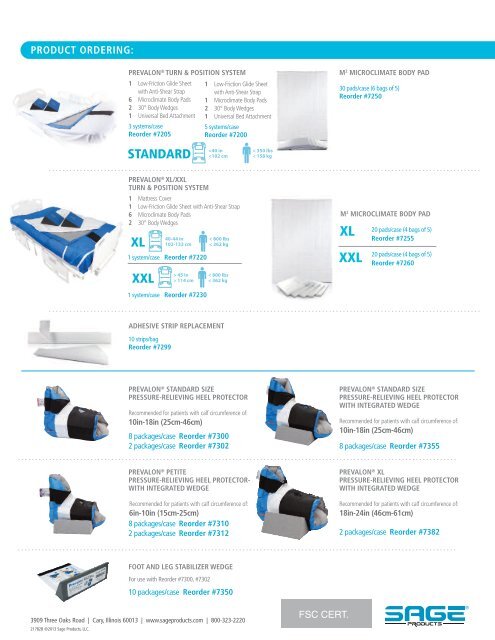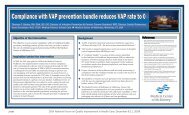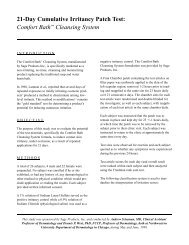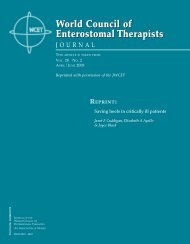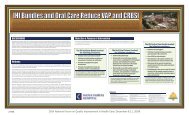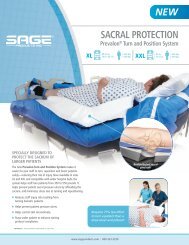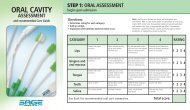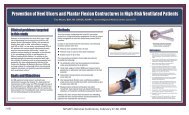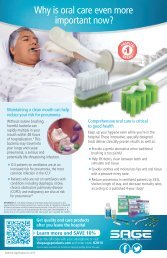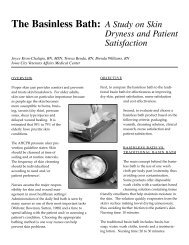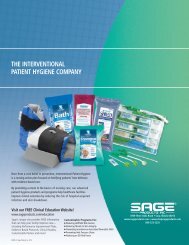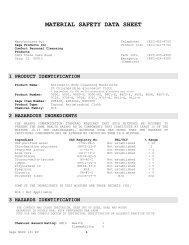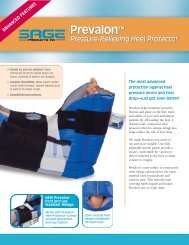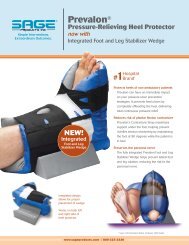Pressure Ulcer Prevention Catalog - Sage Products Inc.
Pressure Ulcer Prevention Catalog - Sage Products Inc.
Pressure Ulcer Prevention Catalog - Sage Products Inc.
Create successful ePaper yourself
Turn your PDF publications into a flip-book with our unique Google optimized e-Paper software.
PRODUCT ORDERING:<br />
PREVALON ® TURN & POSITION SYSTEM<br />
1 Low-Friction Glide Sheet<br />
with Anti-Shear Strap<br />
6 Microclimate Body Pads<br />
2 30° Body Wedges<br />
1 Universal Bed Attachment<br />
3 systems/case<br />
Reorder #7205<br />
STANDARD<br />
1 Low-Friction Glide Sheet<br />
with Anti-Shear Strap<br />
1 Microclimate Body Pads<br />
2 30° Body Wedges<br />
1 Universal Bed Attachment<br />
5 systems/case<br />
Reorder #7200<br />
114 cm<br />
< 800 lbs<br />
< 362 kg<br />
< 800 lbs<br />
< 362 kg<br />
M 2 MICROCLIMATE BODY PAD<br />
1 system/case Reorder #7230<br />
. . . . . . . . . . . . . . . . . . . . . . . . . . . . . . . . . . . . . . . . . . . . . . . . . . . . . . . . . . . . . . . . . . . . . . . . . . . . . . . . . . . . . . . . . . . . . . . . . . . . . . . . . . . . . . . . . . . . . . . . . . . . .<br />
XL<br />
XXL<br />
20 pads/case (4 bags of 5)<br />
Reorder #7255<br />
20 pads/case (4 bags of 5)<br />
Reorder #7260<br />
PREVALON ® STANDARD SIZE<br />
PRESSURE-RELIEVING HEEL PROTECTOR<br />
Recommended for patients with calf circumference of:<br />
10in-18in (25cm-46cm)<br />
PREVALON ® STANDARD SIZE<br />
PRESSURE-RELIEVING HEEL PROTECTOR<br />
WITH INTEGRATED WEDGE<br />
Recommended for patients with calf circumference of:<br />
10in-18in (25cm-46cm)<br />
8 packages/case Reorder #7300<br />
2 packages/case Reorder #7302 8 packages/case Reorder #7355<br />
. . . . . . . . . . . . . . . . . . . . . . . . . . . . . . . . . . . . . . . . . . . . . . . . . . . . . . . . . . . . . . . . . . . . . . . . . . . . . . . . . . . . . . . . . . . . . . . . . . . . . . . . . . . . . . . . . . . . . . . . . . . . . . .<br />
PREVALON ® PETITE<br />
PRESSURE-RELIEVING HEEL PROTECTOR-<br />
WITH INTEGRATED WEDGE<br />
PREVALON ® XL<br />
PRESSURE-RELIEVING HEEL PROTECTOR<br />
WITH INTEGRATED WEDGE<br />
Recommended for patients with calf circumference of:<br />
6in-10in (15cm-25cm)<br />
8 packages/case Reorder #7310<br />
2 packages/case Reorder #7312<br />
Recommended for patients with calf circumference of:<br />
18in-24in (46cm-61cm)<br />
2 packages/case Reorder #7382<br />
. . . . . . . . . . . . . . . . . . . . . . . . . . . . . . . . . . . . . . . . . . . . . . . . . . . . . . . . . . . . . . . . . . . . . . . . . . . . . . . . . . . . . . . . . . . . . . . . . . . . . . . . . . . . . . . . . . . . . . . . . . . . . . .<br />
FOOT AND LEG STABILIZER WEDGE<br />
For use with Reorder #7300, #7302<br />
10 packages/case Reorder #7350<br />
3909 Three Oaks Road | Cary, Illinois 60013 | www.sageproducts.com | 800-323-2220<br />
21782B ©2013 <strong>Sage</strong> <strong>Products</strong>, LLC.<br />
FSC CERT.
PRESSURE ULCER<br />
PREVENTION<br />
Prevalon ® Turn & Position System<br />
Prevalon ® <strong>Pressure</strong>-Relieving Heel Protector<br />
Simple Interventions. Extraordinary Outcomes.
SACRAL<br />
PRESSURE ULCERS<br />
PREVALENCE, RISK AND COST<br />
Facility-Acquired Prevalence by Care Setting<br />
Prevalence(%)<br />
9%<br />
8%<br />
7%<br />
6%<br />
5%<br />
4%<br />
3%<br />
2%<br />
1%<br />
0%<br />
Acute Care<br />
Long-Term Acute Care<br />
Long-Term Care<br />
Rehabilitation Units<br />
2009 2010 2011<br />
5.0%<br />
3.8%<br />
5.2%<br />
4.7%<br />
4.8%<br />
4.4%<br />
5.9%<br />
6.1%<br />
4.5%<br />
8.4%<br />
6.4%<br />
3.7%<br />
Patients are 37.5% more likely to develop a sacral<br />
pressure ulcer when they are immobile & incontinent. 2<br />
n A multi-site acute care study revealed that 19.7% of patients<br />
were incontinent. 3<br />
n 21.7% of the incontinent patients had sacral pressure ulcers. 3<br />
n 20% of the incontinent patients had <strong>Inc</strong>ontinence-Associated<br />
Dermatitis (IAD). 3<br />
n A study in a long-term acute care facility showed IAD prevalence<br />
at 22.8%. 4<br />
n Studies at long-term care facilities show IAD prevalence can<br />
range from 5.6% to 50%. 5<br />
1<br />
GUIDELINES: REPOSITIONING<br />
EUROPEAN PRESSURE ULCER ADVISORY PANEL<br />
(EPUAP) AND NATIONAL PRESSURE ULCER<br />
ADVISORY PANEL (NPUAP) 7<br />
1.1 Repositioning should be undertaken to reduce the duration and<br />
magnitude of pressure over vulnerable areas of the body.<br />
1.2 The use of repositioning as a prevention strategy must take into<br />
consideration the condition of the patient and the support surface in use.<br />
3.2 Avoid subjecting the skin to pressure and shear forces.<br />
3.6 Repositioning should be undertaken using the 30-degree tilted<br />
side-lying position (alternately, right side, back, left side) …<br />
. . . . . . . . . . . . . . . . . . . . . . . . . . . . . . . . . . . . . . . . . . . . . . . . . . . . . . . . . .<br />
WOUND OSTOMY AND CONTINENCE NURSES<br />
SOCIETY (WOCN) 8<br />
III. Interventions: <strong>Prevention</strong><br />
A. Reducing Risk of Developing <strong>Pressure</strong> <strong>Ulcer</strong>s<br />
B. Managing <strong>Inc</strong>ontinence<br />
n Select underpads...that are absorbent to wick incontinence<br />
moisture away from the skin.<br />
. . . . . . . . . . . . . . . . . . . . . . . . . . . . . . . . . . . . . . . . . . . . . . . . . . . . . . . . . .<br />
RISK FACTORS 9<br />
n Reduced mobility or immobility<br />
n Moisture<br />
n Friction and shear<br />
n Acute illness<br />
n Extremes of age<br />
n Vascular disease PRESSURE<br />
n Level of consciousness<br />
The cost to treat a pressure ulcer can range from $2,000<br />
to $70,000 depending on the stage of the ulcer. 6<br />
FRICTION<br />
SACRAL<br />
PRESSURE<br />
ULCERS<br />
MOISTURE<br />
SHEAR<br />
REFERENCES: 1. VanGilder C, Overall Results From the 2011 International <strong>Pressure</strong> <strong>Ulcer</strong> Prevalence Survey. Poster Presented<br />
at WOCN 2012 Annual Conference, Charlotte, NC, June 2012 2. Maklebust J, Magnan MA, Adv Wound Care. Nov<br />
1994;7(6):25,27-8, 31-4 passim. 3. Junkin J, Selekof J, Prevalence of <strong>Inc</strong>ontinence and Associated Skin Injury in the Acute Care<br />
Inpatient. J WOCN May/June 2007;34(3):260-269 4. Long M, et al., <strong>Inc</strong>ontinence-associated dermatitis in a long-term acute care<br />
facility. J WOCN May/June 2012;39(3):318-327. 5. Gray M, at al J Wound Ostomy Continence NURS. 2007 Jan-Feb;34(1):45-<br />
54. 6. Young ZF, Evans A, Davis J. J Nurs Admin (Jona). Jul/Aug 2003; 33 (7/8): 380-3 7. National <strong>Pressure</strong> <strong>Ulcer</strong> Advisory Panel<br />
and European <strong>Pressure</strong> <strong>Ulcer</strong> Advisory Panel. <strong>Prevention</strong> and treatment of pressure ulcers: clinical practice guideline. Washington<br />
DC: National pressure <strong>Ulcer</strong> Advisory Panel, 2009, pp16-18. 8. Wound Ostomy and Continence Nurses Society, Guideline for<br />
prevention and management of pressure ulcers, 2010, pp14-15, 21. 9. Clinical Practice Guidelines: the use of pressure-relieving<br />
devices (beds, mattresses and overlays) for the prevention of pressure ulcers in primary and secondary care. Royal College of<br />
Nursing, Oct 2003.<br />
1 www.sageproducts.com
STAFF INJURY<br />
PREVALENCE, RISK AND COST<br />
While frequent turning and repositioning of patients is<br />
critical to preventing sacral pressure ulcers, it can be<br />
extremely challenging for staff. It can be physically<br />
demanding and require considerable nursing time.<br />
GUIDELINES FOR SAFE<br />
PATIENT HANDLING<br />
OSHA 2009, U.S. DEPARTMENT OF LABOR & STATISTICS 4<br />
. . . . . . . . . . . . . . . . . . . . . . . . . . . . . . . . . . . . . . . . . . . . . . . . . . . . . . . . . .<br />
REPOSITION IN BED: SIDE-TO-SIDE, UP IN BED<br />
. . . . . . . . . . . . . . . . . . . . . . . . . . . . . . . . . . . . . . . . . . . . . . . . . . . . . . . . . .<br />
Manual lifting and other tasks involving repositioning<br />
patients are associated with increased risk of pain and<br />
injury to staff, particularly to the back. 1 Turning and<br />
repositioning puts staff at risk for musculoskeletal<br />
disorders (MSDs), which include conditions such as low<br />
back pain, sciatica and rotator cuff injuries. 1<br />
Fully<br />
Can patient<br />
assist?<br />
No<br />
Partially Able<br />
Use full-body sling lift<br />
or friction-reducing<br />
device and 2 or more<br />
caregivers.<br />
n In 2009, nurses aides, orderlies and attendants<br />
suffered a total of 25,160 MSDs. Registered nurses<br />
suffered a total of 10,480 MSDs. 2<br />
Caregiver assistance<br />
not needed; patient<br />
may/may not use<br />
positioning aid.<br />
Encourage patient to<br />
assist using a<br />
positioning aid or cues.<br />
n 59.2% of these were back injuries requiring an<br />
average of 5 days off work. 12.2% were shoulder<br />
injuries with an average of 8 days off work. 2<br />
In a survey of more than 900 clinicians,<br />
89% said they or a co-worker have<br />
experienced a back, shoulder or wrist<br />
injury due to turning or boosting a<br />
patient. 3 More than 80% said there is<br />
room for improvement in compliance<br />
to their facility’s turning and<br />
repositioning protocol.<br />
If patient is 200<br />
pounds: Use a frictionreducing<br />
device and<br />
at least 3 caregivers.<br />
REFERENCES: 1. Occupational Safety and Health Administration (OSHA), Guidelines<br />
for nursing homes: ergonomics for the prevention of musculoskeletal disorders, 2009.<br />
2. United States Department of Labor, Bureau of Labor Statistics, Nonfatal occupation<br />
injuries and illnesses requiring days away from work, press release 2009, available at<br />
http://www.bls.gov/news.release/osh2.nr0.htm 3. Survey conducted by <strong>Sage</strong><br />
<strong>Products</strong> <strong>Inc</strong>., data on file. 4. OSHA 2009, U.S. Dept of Labor and Statistics, available<br />
at www.osha.gov/ergonomics/guidelines/nursinghome/final-nh-guidelines.html<br />
800-323-2220<br />
2
PREVALON ® TURN &<br />
POSITION SYSTEM<br />
HELPS PROTECT PATIENTS AND STAFF<br />
Turning and repositioning patients according to your facility's<br />
turning schedule is critical to preventing sacral pressure ulcers.<br />
Current methods have multiple challenges, including lack of<br />
nursing time and risk of staff injury.<br />
Unlike standard lift slings and plastic slide sheets, the Prevalon Turn<br />
& Position System stays under the patient at all times. It's always<br />
ready to assist with turning, repositioning and boosting the<br />
patient. This convenience and efficiency makes it possible for<br />
nurses and staff to achieve compliance to a q2˚ turning protocol,<br />
plus it minimizes additional stress on the patient.<br />
SYSTEM COMPONENTS:<br />
LOW-FRICTION GLIDE SHEET<br />
The Low-Friction Glide Sheet remains in place under the<br />
patient throughout the length of stay.<br />
30-DEGREE BODY WEDGES<br />
Two soft foam wedges allow staff to easily position the<br />
patient for consistent protection & pressure redistribution.<br />
M 2 MICROCLIMATE BODY PAD<br />
This innovative, disposable body pad is placed under the<br />
patient to manage heat and moisture.<br />
3 www.sageproducts.com
PROVEN RESULTS:<br />
PREVENTION AND COST SAVINGS<br />
A recent study evaluating the effectiveness of implementing the<br />
Prevalon Turn & Position System in a cardiovascular ICU found<br />
a 63% reduction in development of sacral pressure ulcers over<br />
a 90-day period. A cost analysis showed an estimated annualized<br />
cost savings of approximately CAD$48,700. 1<br />
Another study found that use of<br />
the Prevalon Turn & Position<br />
System to turn and reposition<br />
critically ill patients resulted in a<br />
significant decrease in incidence of<br />
hospital-acquired pressure ulcers<br />
(HAPUs). No HAPUs occurred after<br />
implementing the system, and staff<br />
saw a 60% decrease in time spent<br />
repositioning patients. 35% fewer<br />
staff members were needed to<br />
reposition patients. 3<br />
63%<br />
Sacral <strong>Pressure</strong> <strong>Ulcer</strong><br />
Reduction 1<br />
71%<br />
Less Effort 2<br />
60%<br />
Less Time 3<br />
35%<br />
Less Staff 3<br />
After 8 months of using the Prevalon Turn & Position System,<br />
three hospitals within a medical system saw reductions in hospitalacquired<br />
pressure ulcers of 81%, 73% and 85%. Workers'<br />
compensation incidents in the three facilities were reduced by 89%. 4<br />
LET US HELP YOU VALIDATE YOUR SUCCESS!<br />
CustomerOne is a unique program offered by<br />
<strong>Sage</strong> to reinforce your decision to bring our<br />
products into your facility. It tracks performance<br />
and compliance, and demonstrates improvement<br />
in outcomes.<br />
<strong>Sage</strong> provides customized measurement and<br />
analysis, and compiles your results into valuable,<br />
actionable reports that can be shared with other<br />
decision-makers in your facility. If there’s anything<br />
you need to measure, we can help.<br />
3500<br />
EASIER THAN DRAW SHEETS & PILLOWS<br />
3000<br />
Work to Turn and Position (in-lb)<br />
2500<br />
2000<br />
1500<br />
1000<br />
500<br />
71%<br />
Less Effort<br />
0<br />
Standard Draw Sheet & Pillows<br />
Prevalon ® Turn & Position System<br />
Tests show that the Prevalon Turn & Position System requires 71% less effort<br />
to turn a patient than a standard draw sheet and pillows. 2<br />
REFERENCES: 1. Flockhart L, Fielding C, Use of a repositioning system in postoperative cardiovascular ICU patients results<br />
in a 63% reduction in facility-acquired sacral pressure ulcers. Poster presented at 17th Annual Wound Care Conference,<br />
Nov 2011. 2. Testing conducted by <strong>Sage</strong> <strong>Products</strong> <strong>Inc</strong>., data on file. 3. Hall K, Clark R, Save the butts: preventing sacral<br />
pressure ulcers by utilizing an assistive device to turn and reposition critically ill patients. Poster presented at 25th Annual<br />
Symposium on Advanced Wound Care Spring/Wound Healing Society meeting, Apr 2012. 4. Persby M, Combination of<br />
safe patient handling and use of ergonomic repositioning device reduces hospital acquired pressure ulcers and employee<br />
injury claims. Poster presented at ALTHA 2012 National Clinical Conference, Dallas, TX, May 2012.<br />
CustomerOne can help measure your facility's rate of sacral<br />
pressure ulcers and healthcare worker injury before and after<br />
implementation of the Prevalon Turn & Position System.<br />
Call your <strong>Sage</strong> sales representative<br />
to learn more about CustomerOne.<br />
800-323-2220<br />
800-323-2220<br />
4
PREVALON ®<br />
TURN & POSITION SYSTEM<br />
FOR PATIENTS UP TO 350 LBS.<br />
COMPATIBLE WITH ALL LOW AIR LOSS MATTRESSES<br />
STANDARD<br />
XL/XXL:<br />
FOR BARIATRIC PATIENTS UP TO 800 LBS.<br />
COMPATIBLE WITH ALL LOW AIR LOSS MATTRESSES<br />
All products proudly made in the U.S.A.<br />
XL<br />
40-44 in<br />
102-132 cm<br />
XXL<br />
> 45 in<br />
> 114 cm<br />
Larger size wedges redistribute<br />
pressure for patients.<br />
<strong>Inc</strong>ludes velcro strips that attach<br />
to Low-Friction Glide Sheet,<br />
locking Body Wedges in place<br />
under the patient.<br />
Matress cover secures to any extra-wide<br />
mattress throughout length of stay. Used<br />
in place of a fitted/flat hospital sheet to<br />
help reduce friction.<br />
Larger size Glide Sheet and M 2<br />
Microclimate Body Pad to<br />
accommodate bariatric patients.<br />
Watch the inservice video by scanning the QR code with your smart phone, or visit:<br />
http://www.sageproducts.com/products/sacral-protection/video.cfm?name=Bariatric<br />
800-323-2220<br />
6
HEEL<br />
PRESSURE ULCERS<br />
PREVALENCE, RISK AND COST<br />
The heel and ankle bone are the second and fifth<br />
most common sites for pressure ulcer development. 1<br />
One study finds 43% of hospital-acquired pressure<br />
ulcers (HAPUs) developed on the heel. 2 But, HAPUs<br />
are largely preventable. 3<br />
RISK FACTORS 4,5,6<br />
Impaired mobility<br />
Surgery<br />
Diabetes<br />
FINANCIAL COST:<br />
n<br />
HUMAN COST 7,8,9<br />
Pain<br />
Length of stay<br />
Infection risk<br />
Amputation<br />
Death<br />
The Centers for Medicare and Medicaid Services (CMS)<br />
will not reimburse hospitals for Stage III or IV pressure<br />
ulcers not present on admission (POA). 10<br />
PROFESSIONAL GUIDELINES<br />
AND RECOMMENDATIONS<br />
HEEL ULCER PREVENTION<br />
NPUAP/EPUAP <strong>Prevention</strong> Guidelines<br />
“Ensure that the heels are free of the surface of the bed…<br />
Heel-protection devices should elevate the heel completely (offload<br />
them) in such a way as to distribute the weight of the leg along the<br />
calf without putting pressure on the Achilles tendon.” 5<br />
AHRQ/AHCPR Supported Clinical Practice Guidelines<br />
“Individuals in bed who are completely immobile should have<br />
a care plan that includes the use of devices that totally relieve<br />
pressure on the heels, most commonly by raising the heels off<br />
the bed.” 12<br />
Association of Perioperative Registered Nurses (AORN)<br />
Standards Recommended Practices and Guidelines<br />
“Use devices that eliminate or redistribute pressure” to prevent<br />
perioperative* heel ulcers. 13<br />
. . . . . . . . . . . . . . . . . . . . . . . . . . . . . . . . . . . . . . . . . . . . . . . . . . . . . . . . . .<br />
*Perioperative defined as a pressure-related deep tissue injury under intact skin that presents<br />
within the first 5 days following surgical procedures.<br />
n Costs can range from $2,000 to $30,000 for a Stage I,<br />
II or III ulcer, to $70,000 for a complex, full-thickness<br />
Stage IV ulcer. 11<br />
“The time between development of<br />
a pressure ulcer and the point when the ulcer<br />
becomes visible at the skin varies between<br />
several hours to three to five days.” 5<br />
REFERENCES: 1. Amlung SR, Miller WL, Bosley LM, Adv Skin Wound Care. Nov/Dec 2001;14(6):297-301. 2. Walsh J, DeOcampo<br />
M, Waggoner D, Keeping heels intact: evaluation of a protocol for prevention of facility-acquired heel pressure ulcers. Poster<br />
presented at the Symposium on Advanced Wound Care, San Antonio, TX, Apr 2006. 3. Beckrich K, Aronovitch SA, Nursing<br />
Economic. Sep/Oct 1999;17(5):263-71. 4. Maklebust J, Magnan MA, Adv Wound Care. Nov. 1994;7(6):25 27-8,31-4 passim.5.<br />
National <strong>Pressure</strong> <strong>Ulcer</strong> Advisory Panel and European <strong>Pressure</strong> <strong>Ulcer</strong> Advisory Panel. <strong>Prevention</strong> and treatment of pressure ulcers:<br />
clinical practice guideline. Washington DC: National <strong>Pressure</strong> <strong>Ulcer</strong> Advisory Panel; 2009.6. Levin M, Adv Wound Care. Mar/Apr<br />
1997; 10(2):24-30 7. Fowler E, Scott-Williams S, McGuire J. Practice recommendations for preventing heel pressure ulcers. Ostomy<br />
Wound Management 2008;54(10):42-57. 8. Russo, AC, at al., Hospitalizations Related to <strong>Pressure</strong> <strong>Ulcer</strong>s Among Adults 18 years<br />
and Older, 2006, Heath Care Cost and Utilization Project, Agency for Health Care Research and Quality Statistical Brief #64, Dec<br />
2008. 9. Mannari, at al Successful Treatment of Recalcitrant Diabetic Heel <strong>Ulcer</strong>s with Topical Becaplermin (rh PDGF-BB) Gel,<br />
Wounds. 2002;14(3). 10. Federal Register: Department of Health and Human Services Centers for Medicare & Medicaid Services<br />
Part II, p. 48473 Tuesday, August 19, 2008. 11. Young ZF, Evans A, Davis J, J Nurs Admin (JONA). Jul/Aug 2003;33(7/8):380-3.<br />
12. FAHRQ, <strong>Pressure</strong> Ulcuers in Adults: Prediction and <strong>Prevention</strong>. Clinical Practice Guideline No.3. AHCPR Publication No.92-<br />
0047. Rockville, MD: Agency for Health Care Policy and Research, Public Health Service, US Dept. of Health and Human Services<br />
May 1992. 13. AORN Standards Reccommended Practices & Guidelines 2007. Assoc. Operating Room Nurses.<br />
7 www.sageproducts.com
PREVALON ® PRESSURE-<br />
RELIEVING HEEL PROTECTOR<br />
PROVEN PREVENTION AND TREATMENT OF<br />
HEEL PRESSURE ULCERS AND CONTRACTURES<br />
Protect your patients’ heels with Prevalon—the #1 hospital brand of<br />
heel protection. 1 When used with an effective prevention protocol, it<br />
provides the most advanced protection against heel pressure ulcers and<br />
plantar flexion contracture.<br />
3-IN-1 HEEL PROTECTION<br />
Prevalon floats the heel, prevents plantar flexion<br />
contracture and prevents lateral rotation.<br />
Floats the heel<br />
n Prevalon helps minimize pressure, friction and shear on the feet,<br />
heels and ankles of non-ambulatory patients. It completely off-loads<br />
the heel, delivering total, continuous pressure relief and providing<br />
extra protection for at-risk heels more effectively than special<br />
support surfaces like beds, mattresses and overlays. 2<br />
Look for the blue boot.<br />
When you see it, you know<br />
your patients’ heels<br />
are protected.<br />
Reduce plantar flexion contracture risk<br />
n Contracture Strap maximizes support under the foot, helping prevent<br />
plantar flexion contracture. It helps prevent Achilles tendon<br />
shortening by maintaining the foot at 90.˚<br />
Preserve the peroneal nerve<br />
n Foot and Leg Stabilizer Wedge helps prevent lateral<br />
foot and leg rotation and reduces risk to the peroneal nerve,<br />
which can lead to foot drop.<br />
Contracture Strap<br />
Foot and<br />
Leg Stabilizer Wedge<br />
Integrated wedge helps reduce<br />
lateral rotation and damage to<br />
the peroneal nerve.<br />
REFERENCES: 1. GHX Trend Report (Dollars), 4th Quarter, 2011 Hospital; Annualized markets based on last 4 quarters data. 2 Coats-Bennett U, Critical Care Nursing Quarterly. May 2002; 25 (1):22-32<br />
800-323-2220<br />
8
A HEEL PROTECTION DEVICE<br />
MUST GRIP THE LIMB<br />
In order for a heel protector to be effective and fully offload the heel,<br />
it must stay on the foot in proper position even when the patient<br />
moves. Pillows are frequently used, and although they offload<br />
effectively they do not stay positioned correctly under the limb.<br />
Having to reapply or readjust a heel protector can decrease the<br />
device’s effectiveness and takes valuable nursing time.<br />
Prevalon’s dermasuede fabric<br />
contours to and gently cradles the<br />
leg, calf, ankle and foot to maintain<br />
effective heel offloading.<br />
9 www.sageproducts.com
Published studies cite the ability of the heel protector<br />
to stay on the foot as a factor in its effectiveness in<br />
preventing heel pressure ulcers.<br />
n A recent poster presented at the Symposium on Advanced Wound<br />
Care concluded “as patients shift, the ability of a heel protecting<br />
boot to grip the limb and retain optimal off-loading positioning is<br />
vital to the function of the device.” Furthermore, the study found<br />
evaluation of the heel protector’s grip is necessary for determining<br />
effectiveness in reducing risk of heel pressure ulcers. 1<br />
TO EFFECTIVELY HELP<br />
REDUCE HEEL PRESSURE ULCERS,<br />
A HEEL PROTECTOR MUST:<br />
n Grip the limb<br />
n<br />
Retain optimal offloading position<br />
n Stay in place during patient movement<br />
n<br />
One article found that a heel protector was “more effective<br />
in reducing heel PrU incidence if it did not dislodge during<br />
patient movement.” 2<br />
n<br />
According to another article, clinical considerations in selecting<br />
an optimal heel protector should include the device’s ability to<br />
remain in place while the patient is moving the leg. 3 Testing shows significantly more force is required to dislodge the Prevalon ®<br />
. . . . . . . . . . . . . . . . . . . . . . . . . . . . . . . . . . . . . . . . . . . . . . . . . . . . . . . . . . . . . . . . . . . . . . . . . . . . . . . . . . . . . . . . . . . . . . . . . . . . . . . . . . . . . . . . . . . . . . . . . . . . . . .<br />
PREVALON’S UNIQUE DERMASUEDE<br />
INTERIOR GENTLY GRIPS THE FOOT<br />
Prevalon ® <strong>Pressure</strong>-Relieving Heel Protector was specifically designed<br />
to address the problem of patient movement and its negative effect on<br />
heel offloading. Prevalon’s unique dermasuede interior gently grips the<br />
limb so it remains fully offloaded, even when the patient is moving.<br />
Our highly-engineered fabric and coating process yield a micro-finger<br />
finish for maximum grip control, with the softness of fine velvet. This<br />
soft fabric contours to and cradles the leg, calf, ankle and foot to help<br />
prevent them from rotating within the boot or sliding out of the<br />
boot—maintaining effective heel offloading.<br />
HEEL PROTECTORS’ ABILITY TO GRIP THE LIMB<br />
This innovative dermasuede material is able to hold the limb securely<br />
in place while still preserving patient comfort. It’s breathable, so the<br />
limb remains cool while inside the boot.<br />
<strong>Pressure</strong>-Relieving Heel Protector from the limb than with other heel protectors. 1<br />
REFERENCES: 1. Bill B, Pedersen J, Call E, Human cadaver testing to determine the reliability of heel boot positioning or “grip” of eight commercially available pressure relieving heel protector boots. Poster presented at SAWC, April 2012, Atlanta, GA. 2. Salcido R,<br />
Lee A, Ahn C, Heel pressure ulcers: purple heel and deep tissue injury. Advances in Skin & Wound Care, Aug 2011;24(8):374-80. 3. Lyder C, Getting serious about preventing heel pressure ulcers in hospitals. WCET Journal, Oct/Dec 2011;31(4)6-13.<br />
800-323-2220<br />
10
PROVEN RESULTS:<br />
PREVENTION, TREATMENT AND COST SAVINGS<br />
FROM THE #1 BRAND OF HEEL PROTECTION 1<br />
Prevalon ® brings you more proven clinical studies and financial outcomes than any other brand.<br />
HEEL ULCER REDUCTION<br />
n A study published in JWOCN found the use of Prevalon<br />
and a heel ulcer prevention protocol led to a 95% decrease<br />
in heel pressure ulcers. 2<br />
PREFERRED BY NURSES<br />
A study comparing Prevalon to a waffle-style competitor found,<br />
in addition to achieving zero pressure ulcers, nurses ranked Prevalon<br />
at a statistically significant, higher level of preference. 5<br />
n One facility using Prevalon saw a 100% prevention<br />
of both heel pressure ulcers and plantar flexion contracture,<br />
as well as an annual revenue preservation of $1.9 million. 3<br />
n In one study, implementation of a heel pressure ulcer prevention<br />
protocol that included Prevalon resulted in a 28% decrease in<br />
incidence of facility-acquired heel pressure ulcers over a one-year<br />
period, and a 43% decrease over 22 months. 4<br />
This was due to:<br />
n Comfortable interior<br />
n Not too warm<br />
n No hard, sharp or rough edges<br />
n Floats the heel<br />
n Protects heels from pressure, friction<br />
and shear<br />
n DVT prevention compression<br />
devices compatibility<br />
For the cost to<br />
treat just one Stage IV<br />
pressure ulcer, 6<br />
more than 1,000<br />
Prevalon ® <strong>Pressure</strong>-Relieving<br />
Heel Protectors could<br />
be purchased.<br />
11 www.sageproducts.com
EFFECTIVE<br />
IMPLEMENTATION TOOLS<br />
<strong>Inc</strong>orporating a heel ulcer prevention protocol—combined<br />
with implementation of pressure-relieving devices and early<br />
identification of high-risk patient populations—has been<br />
proven to reduce the risk of developing heel pressure ulcers. 5<br />
A sample protocol, authored by Joyce Black is<br />
available for download at:<br />
www.sageproducts.com/education/pprotocol.asp<br />
To ensure proper use of Prevalon,<br />
a Decision Tree was presented at<br />
the 2008 Symposium on Advanced<br />
Wound Care (SAWC) Conference –<br />
clearing up the mystery behind the<br />
use of “rigid” ankle-foot orthotics<br />
(AFOs) and heel protectors for the<br />
non-ambulatory patient. 7<br />
LET US HELP YOU VALIDATE YOUR SUCCESS!<br />
CustomerOne is a unique program offered by<br />
<strong>Sage</strong> to reinforce your decision to bring our<br />
products into your facility. It tracks performance<br />
and compliance, and demonstrates improvement<br />
in outcomes.<br />
<strong>Sage</strong> provides customized measurement and<br />
analysis, and compiles your results into valuable,<br />
actionable reports that can be shared with other<br />
decision-makers in your facility. If there’s anything<br />
you need to measure, we can help.<br />
CustomerOne can help measure your facility's rate<br />
of heel pressure ulcers before and after implementation of<br />
the Prevalon <strong>Pressure</strong>-Relieving Heel Protector.<br />
REFERENCES: 1. GHX Trend Report (Dollars),4th Quarter, 2011 Hospital; Annualized markets based on last 4 quarters data. 2. Lyman V,<br />
Successful Heel <strong>Pressure</strong> <strong>Ulcer</strong> <strong>Prevention</strong> Program in a Long-Term Care Setting. J Wound Ostomy Continence Nurs. 2009 Nov-Dec;36(6):616-<br />
21. 3. Meyers T, et al., Successful prevention of heel pressure ulcers and foot drop in the high risk ventilation patient population. Poster presented<br />
at Institute for Healthcare Improvement (IHI), Orlando, FL, Dec. 2007. 4..Hanna-Bull D, Heel pressure ulcer prevention—The continued journey<br />
within an acute care facility. Poster presented at WOCN 43rd Annual Conference, June 2011. 5. Walsh JS, Plonczynski DJ. Evaluation of a protocol<br />
for prevention of facility-acquired heel pressure ulcers. J Wound Ostomy Continence Nurs. 2007 Mar-Apr;34(2):178-83.6. Young ZF, Evans A,<br />
Davis J, J Nurs Admin (JONA.) Jul/August 2003;33(7/8):380-3. 7. Fowler E, Scott S, Head over heels: best practices for preventing heel pressure<br />
ulcers. Poster presented at Symposium on Advanced Wound Care, San Diego, CA, April 2008<br />
Call your <strong>Sage</strong> sales representative<br />
to learn more about CustomerOne.<br />
800-323-2220<br />
www.sageproducts.com 800-323-2220 12
PREVALON ® PRESSURE-<br />
RELIEVING HEEL PROTECTOR<br />
Easy to apply, stays on patient’s foot. Stretch<br />
panels adjust quickly for a secure, comfortable<br />
fit. No sharp edges or irritating straps.<br />
Breathable fabric provides good air circulation.<br />
Built-in, pillow-style cushioning<br />
provides proven support surface.<br />
Reduces foot rotation inside boot.<br />
Soft, comfort-grip interior<br />
minimizes friction and shear while<br />
keeping foot in proper position.<br />
Integrated Foot and Leg<br />
Stabilizer Wedge helps prevent<br />
lateral foot and leg rotation,<br />
reducing the risk of damage<br />
to the peroneal nerve.<br />
ICD COMPATIBLE<br />
Pontoon bottom<br />
design helps keep foot<br />
in upright position.<br />
Watch the inservice video by scanning the QR code with your smart phone, or visit:<br />
http://www.sageproducts.com/products/heel-protection/video.cfm<br />
13 www.sageproducts.com
Durable exterior slides easily over<br />
bed sheets. Helps maintain patients’<br />
freedom of movement. Ripstop nylon<br />
exterior is the same material used in<br />
parachutes and outdoor gear.<br />
All products proudly made in the U.S.A.<br />
Tag helps clinicians<br />
visualize how to<br />
properly apply boot.<br />
Contracture Strap delivers<br />
maximum support to the<br />
bottom of the foot,<br />
helping prevent plantar<br />
flexion contracture.<br />
XL<br />
Open, floated-heel design<br />
completely off-loads heel;<br />
allows for easy monitoring<br />
between assessments.<br />
STANDARD<br />
PETITE<br />
Distinctive blue color<br />
contrasts with white bed<br />
sheets for easy monitoring.<br />
REFERENCES:<br />
1. GHX Trend Report (Dollars),4th Quarter, 2011 Hospital; Annualized markets based on last 4 quarters data.<br />
1<br />
www.sageproducts.com 800-323-2220 14


